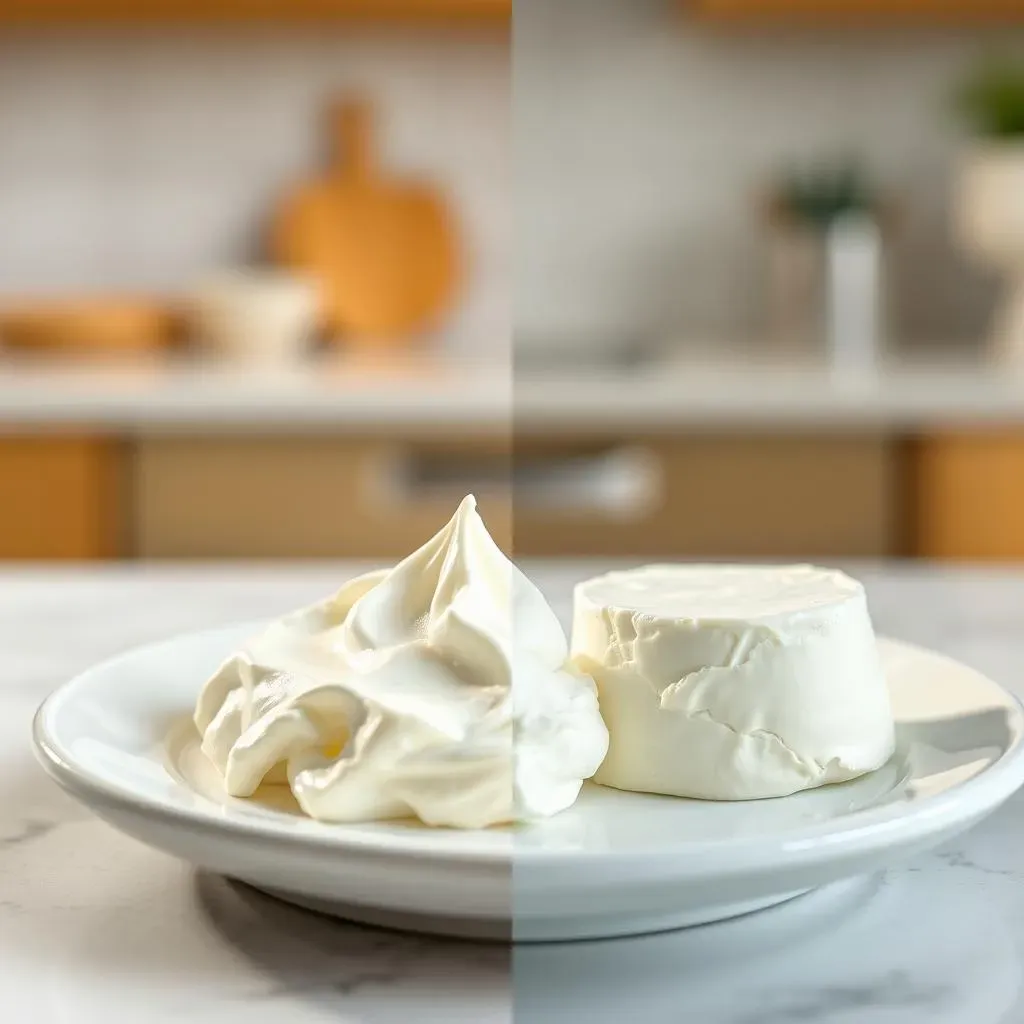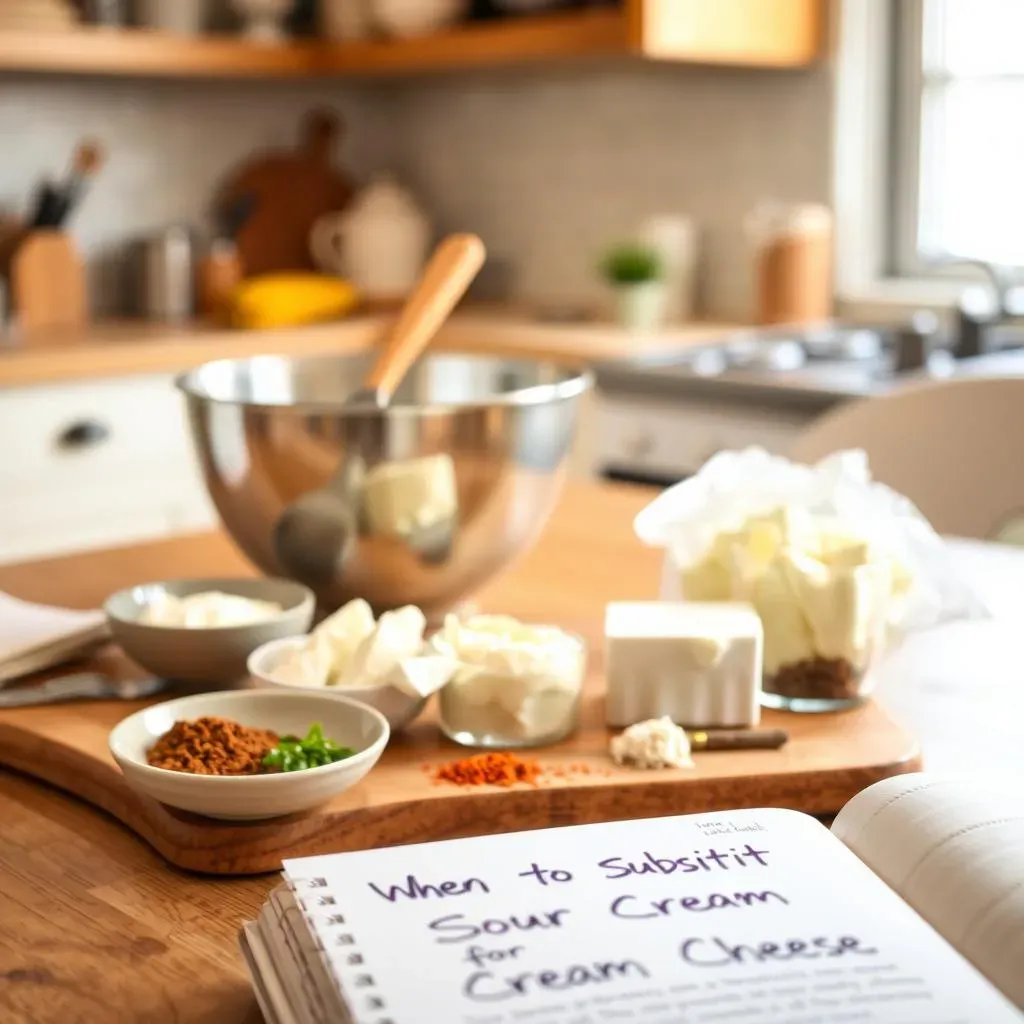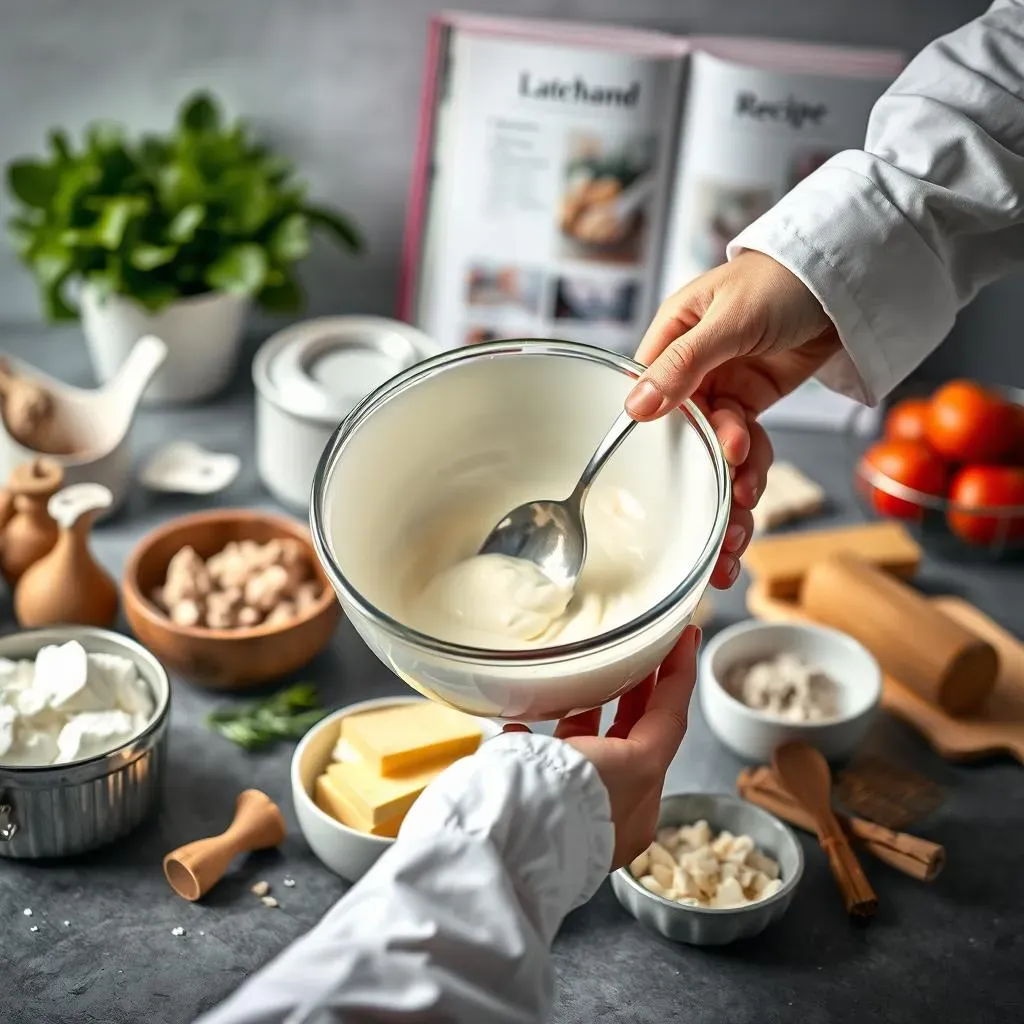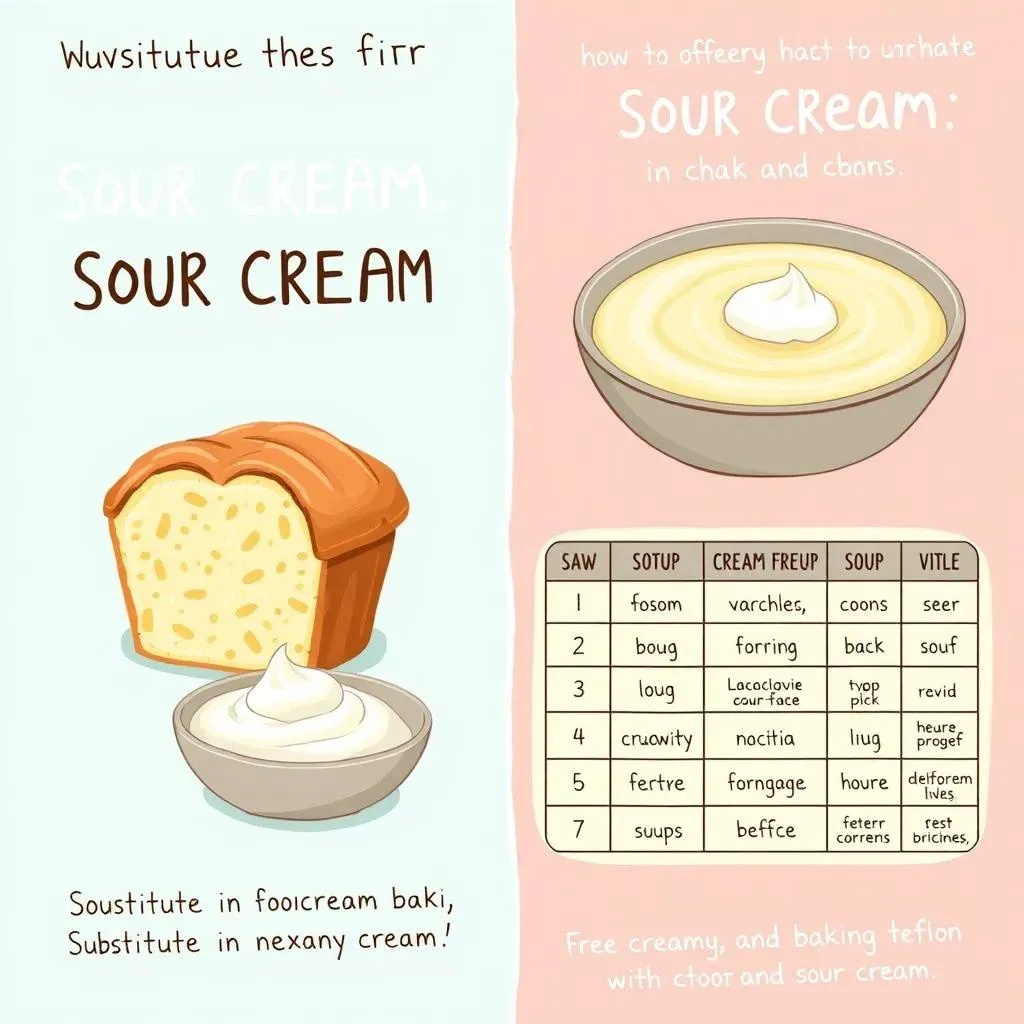Table of Contents
Ever found yourself in the middle of a recipe, only to discover you're fresh out of cream cheese? It's a kitchen crisis we've all faced, but don't worry, there's a simple solution! This article is your guide on how to substitute sour cream for cream cheese. Yes, you heard right. While they aren't identical twins, sour cream can be a surprisingly good stand-in, especially when you know the tricks. We'll start by looking at what makes these two dairy delights different, exploring their unique textures and flavors. Then, we'll explore when swapping them works best and, more importantly, when it doesn't. You'll learn how to make the swap effectively, ensuring your dishes still taste great. Finally, we'll tackle specific baking and cooking scenarios, giving you the confidence to make this substitution like a seasoned chef. So, let's get started and turn that kitchen mishap into a culinary win!
Understanding the Differences: Sour Cream vs. Cream Cheese

Understanding the Differences: Sour Cream vs. Cream Cheese
Alright, let's get down to the nitty-gritty. Sour cream and cream cheese, while both creamy and delicious, are totally different beasts. Think of it like this: cream cheese is the dense, sturdy friend, the one who's always there to hold things together. It’s got a high fat content, which is why it's so thick and spreadable. On the other hand, sour cream is the cool, tangy cousin. It's got a higher moisture content, making it lighter and more, well, pourable. It's got that characteristic tang thanks to lactic acid, a result of the fermentation process. So, while they both live in the dairy aisle, their personalities are quite different. One’s the reliable backbone of a cheesecake, the other’s the zesty topping for your tacos. See the contrast?
When to Substitute Sour Cream for Cream Cheese

When to Substitute Sour Cream for Cream Cheese
Okay, so when can you actually swap these two? Think of it this way: sour cream shines when you're looking for a bit of tang and moisture, but not necessarily the same structural support as cream cheese. For instance, if you're making a dip or a sauce, sour cream can work wonders. It'll add that creamy texture and a slight zing that can elevate the flavor. Think of a creamy pasta sauce – sour cream can bring a lovely lightness. It also works well when you're looking for a topping, like a dollop on baked potatoes or chili. However, if your recipe relies heavily on cream cheese for its thickness and structure, like a cheesecake or a frosting, a straight swap might not give you the results you’re hoping for. You'll want to be more strategic about it, which we’ll get into in the next section.
Let's be real though, sometimes, you just need a sub and you need it now. Maybe you're whipping up a batch of enchiladas and realize you're completely out of cream cheese for the filling. Or perhaps you're trying to make a batch of cookies and only have sour cream in the fridge. These are the moments when a little kitchen creativity is needed. The trick is to understand what each ingredient brings to the table. Cream cheese is all about that rich, dense texture, while sour cream is more about tang and moisture. So, it's not always a perfect one-to-one swap, but with a few adjustments, you can make it work. Think of it as a culinary adventure, where you're the hero who saves the day with your substitution skills.
Use Sour Cream When | Avoid Sour Cream When |
|---|---|
Making dips or sauces | Baking cheesecakes |
Topping baked potatoes or chili | Creating thick frostings |
Adding moisture to baked goods | Recipes that require a firm structure |
How to Substitute Sour Cream for Cream Cheese Effectively

How to Substitute Sour Cream for Cream Cheese Effectively
The Moisture Factor
Okay, so you're ready to get your hands dirty and start swapping. The first thing you need to think about is the moisture content. Since sour cream is more liquid than cream cheese, you might need to adjust your recipe. If you're using it in a dip or a sauce, this is usually not a problem, you can just go for it. But if you're putting it in a baked good, you may need to reduce other liquids in the recipe by a bit. For example, if the recipe calls for milk or water, try using a tablespoon or two less than usual. This helps to balance out the extra moisture from the sour cream and prevents your dish from becoming too runny. It's all about finding that sweet spot, right?
Thickening Things Up
Sometimes, you need that cream cheese thickness, and sour cream on its own just isn't cutting it. That's where thickening agents come in. A little bit of cornstarch can work wonders. Just mix a teaspoon or two with your sour cream before adding it to the recipe. Another option is to use a bit of flour. Start with a small amount, like half a teaspoon, and add more gradually until you reach the desired consistency. You can also try straining the sour cream. Line a sieve with cheesecloth and let the sour cream sit in it for a few hours. This will help to remove some of the excess liquid, making it thicker and more like cream cheese. It’s like giving your sour cream a little makeover!
Technique | How to Do It | Best Use |
|---|---|---|
Reduce Liquids | Use less milk or water in recipe. | Baking, sauces |
Add Thickener | Mix cornstarch or flour with sour cream. | Dips, sauces, baking |
Strain Sour Cream | Place in cheesecloth-lined sieve to remove excess water. | Any recipe needing a thicker consistency |
Flavor Adjustments
The last piece of the puzzle is flavor. Sour cream has that distinctive tang that cream cheese doesn't. This can be a good thing, adding a little zip to your dish. But sometimes, you want that mild, creamy flavor of cream cheese. If that's the case, you can mellow out the sour cream's tang with a touch of sweetness. Try adding a pinch of sugar or a bit of honey. You can also use a small amount of cream to make it richer. Taste as you go and add more until you achieve the flavor you want. It’s all about balancing those flavors, like a master chef!
Baking and Cooking: Tips for Substituting Sour Cream for Cream Cheese

Baking and Cooking: Tips for Substituting Sour Cream for Cream Cheese
Baking with Sour Cream: A Few Pointers
Okay, let's talk baking! This is where things get a little more delicate, but trust me, you can still rock it. When you're swapping sour cream for cream cheese in baked goods, it's all about understanding the recipe's structure. For instance, if you're making a cake or muffins, the sour cream can actually add a lovely moistness and a slight tang. Think of it like a secret ingredient that makes your treats extra special. But, and this is a big but, don't expect the same dense texture you'd get with cream cheese. Instead, your cakes might be a bit lighter and more tender. This isn't a bad thing! It's just different, so embrace it.
Now, when it comes to frostings, that's where you might need to be a bit more careful. Sour cream on its own won't give you the same stiff, spreadable frosting you get with cream cheese. You'll need to get creative with your thickeners. Adding a bit of powdered sugar can help to firm things up, but be careful not to add too much, or it could get overly sweet. You can also try using a bit of cornstarch or even a small amount of melted white chocolate to give your frosting that needed structure. It's all about experimenting and seeing what works best for your recipe.
Cooking with Sour Cream: Savory Sensations
Moving onto the savory side of things, sour cream can be a real star in cooking. It’s fantastic for adding creaminess to sauces and soups without being too heavy. Think about adding a dollop to your tomato soup for a tangy twist, or stirring it into a curry to make it extra rich. It's also a great way to finish a pan sauce, giving it a velvety texture and a bit of a zing. Just remember to add it at the very end, after you've taken the pan off the heat. This prevents the sour cream from curdling, which is not a good look.
Sour cream is also a great substitute for cream cheese in dips and spreads. It'll give you a similar creamy base, but with a little more tang. If you're making a spinach artichoke dip, for instance, sour cream can be a fantastic substitute, and honestly, it might even taste better! You can also use it as a base for salad dressings, adding a creamy element without being too heavy. The key is to taste as you go and adjust the flavor accordingly. If you find the tang is too much, try adding a touch of sweetness or a little more fat, like a bit of olive oil.
Baking Scenario | Sour Cream Effect | Tips |
|---|---|---|
Cakes & Muffins | Moist, tender texture | Reduce other liquids |
Frostings | Lighter, less stable | Add powdered sugar or thickener |
Cooking Scenario | Sour Cream Effect | Tips |
Soups & Sauces | Creamy, tangy flavor | Add at the end of cooking |
Dips & Spreads | Creamy base, tangy twist | Adjust seasoning to taste |
Real-World Examples and Quick Tips
Let's get real, sometimes you just need a quick fix, right? So, here are some real-world examples of when you can use sour cream instead of cream cheese. Imagine you're making a batch of brownies and realize you're out of cream cheese for the swirl. Don't panic! Use sour cream. It won't give you the same distinct swirl, but it'll still add a lovely moistness and a subtle tang that makes your brownies extra good. Or, what about when you're making a breakfast casserole? Sour cream is your friend. It can replace the cream cheese, giving your casserole a creamy texture without being too heavy. It's all about being flexible and knowing how to adapt to what you have on hand.
Here are a few quick tips to keep in mind. If you're using sour cream in a recipe that calls for a lot of cream cheese, consider using a combination of sour cream and something else to give you more structure, like a thick Greek yogurt. This will give you the best of both worlds. And always, always taste as you go. This way, you can adjust the flavors and textures to your liking. Remember, cooking and baking is all about experimentation, so don't be afraid to get a little creative and see what happens. You might just discover a new favorite way to use sour cream!